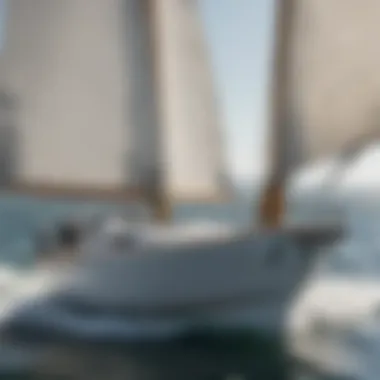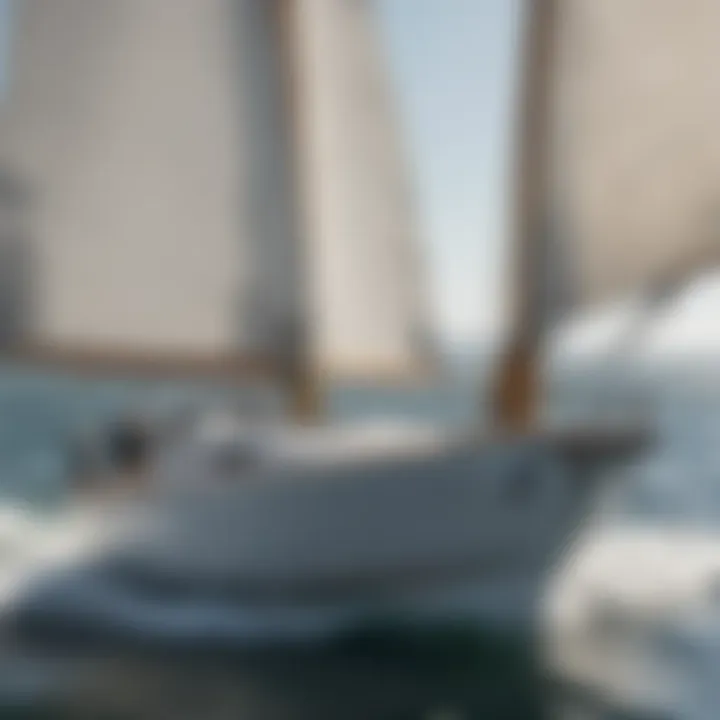Fastest Sailboats: Speed, Design, and Technology Insights


Intro
In the realm of sailing, the quest for speed is both an art and a science. Sailboats, once seen purely as vessels for leisure, have morph into remarkable feats of engineering, pushing the boundaries of marine innovation. Understanding what makes the fastest sailboats tick is key for anyone intrigued by the salty spray of the sea. From the way the hull is shaped to the materials used in their construction, each detail plays a vital role in the dance between wind and water.
As we venture further, we will break down the intricate relationship between design, technology, and performance, revealing how historical milestones in sailboat development have led us to the titans of today's waters. Whether you're an eager novice or a seasoned captain, the lessons learned here can feed your passion and enhance your skills on the waves.
Techniques and Skills
The nuances of sailing are profound and varied. From the simplest maneuver to advanced sailing techniques, understanding these elements can take your experience from good to exhilarating.
Essential Techniques for Beginners
Starting strong is essential for any budding sailor. Here are some fundamental techniques to get your sea legs:
- Basic Knots: Mastery of knots like the bowline or the clove hitch can make a world of difference. These knots ensure that sails and gear remain secure under the pressure of wind and sea.
- Tacking and Jibing: Learning how to efficiently change direction can improve your speed and control. Tacking is when you sail against the wind, while jibing is with the wind. Knowing when to use each maneuver is crucial.
- Sail Trim: Adjusting the sails to catch the wind just right will maximize speed. Tighter sails can boost speed, while looser sails can aid in controlling the boat.
Advanced Skills for Experienced Watersport Enthusiasts
For those already familiar with the seafaring basics, enhance your skills with these advanced techniques:
- Performance Sailing: This includes techniques like heeling, where the boat leans to one side to catch more wind. Learning to balance this correctly can allow for faster speeds.
- Race Tactics: Understanding wind patterns, currents, and opposing boats can help in strategizing during races. It’s not just about speed; it’s about playing the odds on the water.
- Navigating Conditions: Experience weathering storms, recognizing changing patterns, and adjusting sails to maintain control can elevate an expert sailor's ability to manage extreme conditions.
"Knowledge is like the wind; it guides the sailboat of your career across the infinite sea of opportunities."
Equipment and Gear
The tools of the trade can greatly influence your sailing speed and experience. Selecting the right equipment is not merely a matter of preference but a strategic decision that can impact performance.
Must-Have Gear for Each Watersport
Here’s a breakdown of essential gear that enhances sailing performance:
- Sailboat Types: Different types of boats, like catamarans or monohulls, offer distinct advantages. For speed, catamarans are known for their ability to skim across the surface.
- Sails: High-tech materials such as carbon fiber or mylar can dramatically reduce drag and increase speed.
- Navigation Tools: GPS devices and weather apps are invaluable. They allow for quick course adjustments based on the latest forecasts and conditions.
Tips for Selecting the Right Equipment
When selecting equipment, consider these tips:
- Research Products: Understand the specifications regarding materials and weight distribution. Sails should be lightweight and durable.
- Fit Matters: Ensure that the gear fits the sailor and the boat correctly. An ill-fitting sail or life jacket can hinder performance and safety.
- Invest Wisely: Sometimes, investing in high-quality gear upfront can save you headaches and costs down the road. A well-made sail can last seasons longer than a cheap one.
As we journey deeper through the world of fast sailboats, the interplay between cutting-edge design, innovative materials, and sailor ingenuity will unravel, offering insights that inspire and inform. From the novice taking their first steps to the racer chasing records, this exploration sets a foundation for understanding the magnificent machines that glide across waters worldwide.
Understanding Sailboat Speed
Sailboat speed is a multifaceted concept that encompasses various factors ranging from design elements to environmental influences. Understanding this topic is crucial for anyone interested in the performance of sailboats, whether you are a seasoned sailor or a curious novice. This knowledge can enhance sailing experiences, allowing one to appreciate the fine intricacies of how speed is achieved on water.
Speed in sailing is not merely about how fast a vessel can move, but also involves nuances such as how efficiently it can harness the wind. An effective sailboat blends various design features and technology to optimize performance and maneuverability. When looking at fast sailboats, one can see that just as much attention is paid to creating a sustainable balance between speed and safety. While the thrill of racing might attract many to the sport, understanding the principles behind sailboat speed can ensure safer and more enjoyable sailing experiences.
Defining Speed in Sailing
In the realm of sailing, speed is typically quantified in knots, a maritime unit equivalent to nautical miles per hour. However, speed encompasses much more than this simple measurement. To truly grasp the concept, we must look at the combination of factors such as hull design, weight distribution, sail area, and wind conditions.
Key elements influencing speed include:
- Wind Speed: The more powerful the wind, the faster the sailboat can potentially travel.
- Sail Area: Larger sails can catch more wind, translating into greater speed, but they also require careful management.
- Hull Shape: A sleek hull design minimizes drag, allowing for smoother movement through water.
Understanding these factors sheds light on why certain sailboats are quicker than others. It becomes clear that speed isn't just a singular attribute but rather a result of harmonizing various design and environmental elements together.
The Science of Sailing Dynamics
The principles behind how sailboats attain speed are rooted in both aerodynamics and hydrodynamics, which deal with how air and water interact with the boat, respectively.
Aerodynamics and Hydrodynamics
Aerodynamics refers to the behavior of air as it encounters a moving object, or in this case, a sailboat. Understanding aerodynamics is imperative, as it directly affects how effectively sails can harness wind power.
A key characteristic of effective aerodynamic design is the use of efficient shapes in sails that allow wind to flow smoothly and avoid turbulence. This can enhance lift, effectively using the wind's energy to propel the vessel forward. The unique feature of well-designed sails, like those with wing-like profiles, improves performance but requires knowledge in sail trim to navigate varying conditions.
Hydrodynamics, on the other hand, looks at the flow of water around the hull. Properly shaped hulls minimize resistance, hence increasing speed. A beneficial choice in this article would be designs that incorporate dual-purpose elements, like a bulb keel, which not only provides stability but also enhances speed by reducing drag.
Wind Interaction and Sail Shape
Wind interaction with sail shape plays a significant role in determining a sailboat's speed. The angle at which wind strikes the sails is crucial; this angle, called the angle of attack, can significantly influence performance.
A key characteristic of optimized sail shape is its ability to manipulate airflow. For example, a sail that inflates correctly can channel wind efficiently, promoting lift and potentially leading to greater speeds. A unique feature would be the camber in a sail, allowing sailors to adjust how it catches the wind, offering the flexibility needed for varying conditions. However, intricate sail adjustments can sometimes be a disadvantage for less experienced crews who might struggle with fine-tuning.
"Grasping the nuances of wind dynamics and sail form is essential for any sailor aiming for top performance."
Overall, the relationship between wind and the sail shape is an intricate dance, making it imperative for sailors to master both the theoretical and practical aspects of sailing to truly excel in speed.


Historical Context of Fast Sailboats
Understanding the historical context of fast sailboats offers a rich tapestry that showcases how far sailing technology has come. The story of these vessels is not just about speed; it’s an equation involving design philosophy, cultural importance, and competitive spirit that has evolved through time. With advancements in materials and design techniques, sailboats have gone from simple wooden crafts to sophisticated, high-performance machines. This evolution highlights the human desire for exploration and competition, showcasing the relevance of each technological breakthrough in fast sailing.
Evolution of Sailboat Design
Sailboat design has seen significant transformations, from the rudimentary rafts of ancient civilizations to the sleek, cutting-edge designs that dominate sailing competitions today. The shape, materials, and rigging of sailboats have been fine-tuned over centuries. Early designs focused on stability and cargo capacity, but as racing emerged as a sport, speed and agility took center stage.
In the 19th century, the introduction of the schooner and later, the America's Cup class, kicked off a race not just for victory but for innovation. Designers began to think outside the box, experimenting with various hull shapes, sail configurations, and even the mechanics of the keel—each step leading toward increased speed on the water. These changes are not merely cosmetic; they’re foundational shifts in how boats generate lift and navigate through waves.
Key Historical Milestones
The journey of fast sailboats is marked by several key events that have shaped the landscape of competitive sailing.
Famous Fast Sailboat Races
Among the hallmarks of sailing history are the races that have tested the limits of speed and design. Noteworthy events include the famous America's Cup, the challenge for supremacy which started in 1851, and the Whitbread Round the World Race, emphasizing endurance and skill along with speed.
These races serve not only as competition platforms but also as testing grounds for new technologies and designs. For instance, the introduction of the 12-Metre Class in the America’s Cup led to advancements in hull design and sail effectiveness, refined by each competing team. This spirit of competition pushes designers to innovate, ensuring that the quest for speed is relentless. The fast sailboat races give birth to a myriad of design philosophies that ripple through the sailing community.
Influential Designers and Builders
As we delve into the character of sailboats, it’s impossible to ignore the impact of key designers and builders who have left indelible imprints on the craft. Figures like Nathaniel Herreshoff and Olin Stephens revolutionized yacht design with ideas that blended aesthetic beauty with engineering prowess. Their thoughts on factors such as rigging tactics and hull shapes continue to resonate in contemporary design.
This approach to design emphasizes not simply speed but a holistic understanding of how each element interacts with the forces of nature. Historical designers recognized that building a fast sailboat isn’t just about perfecting one aspect; it’s an orchestrated harmony of components working together—a truly symphonic endeavor.
As modern builders draw on these teachings, they blend traditional craftsmanship with the latest technology to create sailboats that hark back to their heritage while pushing the envelope of what is possible.
"The significant advances in every facet of design echo the passion for speed and the continuous drive for improvement in the sailing community."
Design Features of Fast Sailboats
When it comes to fast sailboats, design features are the backbone of their performance. Every curve, angle, and material choice plays a significant role in how quickly a sailboat can cut through the water. It's not just about aesthetics; every design element has been honed and tested to maximize speed. Sailors and manufacturers alike know that the right design can make all the difference between winning and losing during races. Understanding these intricate aspects enables enthusiasts to appreciate the fine line between art and engineering in sailboat design.
Hull Design Innovations
Length and Beam Ratios
Length and beam ratios are crucial in determining a sailboat's speed and stability. A longer hull generally translates into lesser drag while slicing through the water, allowing for increased velocity. The beam—representing the boat's width—affects how much sail area can be carried without compromising stability. A prevalent ratio that many modern designs adhere to might sit around 8:1, balancing length and width efficiently.
One key characteristic is that greater length often leads to improved speed as it encourages a streamlined flow of water around the hull. Conversely, a wider beam can help in carrying larger sail areas, thus aiding in harnessing wind better. However, a wider hull could also create more drag if not appropriately balanced. While it sounds enticing to maximize the beam for speed, it can backfire in rough conditions.
The unique aspect of sailing is in these specific ratios; those ratios allow for both speed in calm waters and stability when conditions get bumpy. A badly judged beam can lead to tipovers, which isn’t ideal for competitive sailing. Therefore, it becomes clear that having the right length and beam ratio is often a winning strategy in speed sailing.
Fin Keels and Rudder Configurations
Fin keels and rudder configurations are equally pivotal in boat design and contribute significantly to a sailboat’s performance. A fin keel offers better control and stability, particularly during high-speed maneuvers. What sets fin keels apart in today's fast sailboats is their design: they are less drag-inducing while allowing the sailboat to maintain its course.
A key characteristic of fin keels is their ability to lower the center of gravity. This helps a boat stay upright even at sharp angles, allowing for faster turns without compromising safety. Pairing these with efficient rudder configurations gives the sailor the edge needed during races, allowing swift directional changes with minimal effort.
One drawback is that fin keels require precise construction and alignment. If misaligned, they can create turbulence which negates speed benefits. Still, their advantages outweigh the risks, and they have become a popular choice for modern racing sailboats.
The Role of Sail Configuration
Sail configuration is another important design feature directly impacting speed. Properly configured sails capture wind effectively, turning kinetic energy into propulsion. Different types of sails are designed for various wind conditions, which can significantly affect overall performance.
Types of Sails: A Closer Look
The various types of sails available—such as mainsails, jibs, and spinnakers—offer unique functionalities. A significant factor to consider is that each sail type has varying surface areas, directly influencing the amount of wind they can harness. For example, spinnakers are ideal for downwind sailing because of their large surface area.
The key characteristic here is adaptability. Sailboats with multiple sail options can switch gears depending on wind conditions, maximizing speed and efficiency. A drawback could lie in managing interactions between different sails—if not handled correctly, they can interfere with each other, reducing overall speed.
Adjustability and Sail Trim
Adjustability and sail trim allow sailors to tweak their setups for optimal performance. Think of it like a musician tuning their instrument before a concert; every adjustment can enhance the final speed. Fine-tuning the angle at which the sails catch the wind changes how efficiently a sailboat can accelerate.
The unique benefit of this feature is precision. Being able to adjust sails on-the-fly helps sailors respond to changing conditions, keeping them competitive. However, constant adjustments require experience. A newbie sailor may struggle, potentially leading to missed speed opportunities amid stiff competition.
"Mastery in sailing isn't just about the craft itself, but the knowledge of when and how to adjust it for success."
Overall, the design features of fast sailboats illustrate a remarkable balance of technical innovation and practical application. Understanding these features enriches one’s perspective, fostering a deeper appreciation for the craftsmanship that goes into creating some of the fastest vessels on the water.
Materials and Technology in Sailing
The world of sailing has continually evolved, with materials and technology playing a central role in enhancing the performance of sailboats. The right materials can significantly impact speed, durability, and overall sailing experience. This section digs into how advancements in materials not only influence the design and performance of fast sailboats but also reflect the ongoing innovations in the sailing community.
Advanced Materials for Speed Enhancement
Carbon Fiber and Kevlar


Carbon fiber and Kevlar have forged a reputation as cornerstone materials in high-performance sailing. Their lightweight nature combined with substantial strength allows for sleek designs without compromising on durability.
One of the standout traits of carbon fiber is its high tensile strength, which makes it an ideal candidate for structures that need to withstand both the force of wind and the stresses from waves. It's particularly suited for masts and hulls, lending itself well to fast and agile sailboats. On the other hand, Kevlar excels in applications needing flexibility and resilience, perfect for rigging and sails that face dynamic pressures.
However, while these materials boast impressive characteristics, they do come with their drawbacks. Manufacturing carbon fiber can be resource-intensive, and repairs can be complicated and costly. Still, their advantages often outweigh these concerns, establishing them as popular choices among designers aiming for speed.
Composite Materials and Their Benefits
Composite materials have taken the sailboat arena to new heights. They blend different substances to create unique material properties that neither could achieve alone. Often created by combining carbon fiber, Kevlar, and resins, these composites result in a strong yet lightweight option for sailors.
The key characteristic of composite materials is their versatility. They can be tailored specifically for different parts of the boat, allowing designers to enhance stiffness in hulls while ensuring flexibility in the sails. This capability leads to improved handling and speed on the water, making composite materials an extremely beneficial choice within the industry.
Despite their clear advantages, composites can have downsides too. The intricate manufacturing processes involved can be both time-consuming and expensive, which may deter some builders. However, their performance benefits immensely contribute to their popularity in the top-tier racing circuits.
Innovations in Rigging Systems
Rigging systems are often overlooked yet essential components in sailing speed. Innovations in this area have led to significant advancements. Modern materials allow for the use of jib tracks and adjustable backstays that help fine-tune a boat's performance depending on weather conditions.
With improved designs and the application of technology like hydraulic systems, sailors today can make quick adjustments to optimize sail shape and angle instantly. This responsiveness is vital during races where every second counts. Progress in these systems reflects a broader trend of marrying technology with traditional sailing practices, ensuring the fastest boats also leverage the best information available.
The journey towards the fastest sailboats is paved with innovations in materials and technology, paving the way for an evolution that never stops.
Current Champions in Sailing Speed
The topic of current champions in sailing speed is central to our exploration of the fastest sailboats. It provides a snapshot of the pinnacle of sailing technology and design, showcasing the vessels that have pushed boundaries in terms of performance. By examining these champions, we gain insights into the meticulous details that contribute to velocity on water, while also appreciating the skill involved in maneuvering these craft. This section highlights popular fast sailboat models, influential racing events, and what their triumphs mean for the future of sailing.
Notable Fast Sailboat Models
America's Cup Winners
America's Cup winners represent the zenith of competitive sailing. These boats are not just vessels; they are a product of cutting-edge engineering and design prowess. The beauty lies in their ability to combine speed with agility, crucial for success in one of the most prestigious sailing competitions in the world.
A key characteristic of America's Cup winners is their multihull design, particularly seen in the latest iterations. This design enhances stability and speed, allowing for faster tacking and reaching. The foiling technology, where the hull lifts out of the water to reduce drag, has revolutionized sailing, making these boats remarkably fast. This ability to harness wind and water dynamics is a distinct advantage that sets them apart in competitive racing.
However, these high-performance boats come with their own set of challenges. Maintenance costs are steep, and the skill required to handle them is extensive, often requiring teams of seasoned sailors. Yet, for those who live for the thrill of the race, the rewards far outweigh the drawbacks.
Record-Setting Yachts
Record-setting yachts have carved a niche in the history of competitive sailing, often becoming the benchmark for design and performance. These boats frequently push the limits of what is technically possible on water, leading to innovations that can benefit the broader sailing community.
The defining characteristic of these yachts is their sheer speed, which is often measured by the records they set in various races. Notable examples include the Banque Populaire and Hydroptere, known for their groundbreaking use of hydrofoils. The hydrofoils allow for sustained speeds that challenge the traditional understanding of sailing performance.
What makes record-setting yachts particularly fascinating is their experimental nature. They often test new theories in hydrodynamics and design, which can trickle down to recreational sailors and influence the market. Though these cutting-edge designs can be tricky to maneuver and often come with high price tags, they represent the frontier of sailing technology and inspire sailors to push their own limits.
The Future of Fast Sailing
Looking ahead, the future of fast sailing seems bright and filled with possibilities. Innovations in marine technology, such as renewable energy integration and enhanced materials, are likely to further boost sailing speeds while maintaining environmental sustainability. The growing interest in sailing as a sport and recreational activity means that the passion for speed will only continue to grow.
As racing events become more popular and competitive, there’s a push not just for speed but also for inclusivity in sailing communities. By fostering new talent and embracing diverse sailing styles, the sport of sailing can evolve, creating a rich tapestry of experience and expertise that will drive future champions in sailing speed.
Sailing is not merely a race against time; it’s an ongoing journey of discovery and innovation.
Impact of Environmental Factors on Sailing Speed
Understanding the impact that environmental factors have on sailing speed is crucial for any serious competitor or enthusiast. The dynamics of sailing are heavily influenced by a variety of elements including wind patterns, water currents, and even weather conditions, all of which can change the game drastically for sailors who are aiming for optimal performance.
Wind accessibility is arguably the most significant environmental element that dictates how fast a sailboat can glide across the water. However, it’s not just about having wind; it’s about how that wind interacts with the sails. Understanding the subtleties of local wind patterns is essential. For example, a seasoned sailor can tell you that the famous "thermal winds" that occur in some coastal areas can provide a significant boost to achieve thrilling speeds.
Then we have the water itself. The condition of the water surface—whether it's flat or choppy—can either enhance or inhibit speed. High-performance sailboats operate best when conditions are just right, creating a delicate balance between elements. Let's dig deeper into these two pivotal components:
Role of Wind Patterns
Wind patterns are foundational to sailing. Their direction, consistency, and intensity can change course in an instant, leading to variations in speed that can make or break a race. Experienced sailors watch for shifts in wind direction that could come from unexpected gusts. Also, understanding local topography can provide insights into how the wind may funnel through valleys or around hills, leading to conditions that are either favorable or turbulent.
It is common to find that winds often shift at different times during the day. The morning may greet you with gentle breezes, but as the sun rises, thermal winds can kick in, giving sailors the push they need to speed ahead. Not to mention, the phenomenon known as "wind shadow" caused by land formations can create patches of still air that drastically slow a boat down if sailed into.
Water Conditions and Their Effects
Water conditions—current speed, temperature, and wave patterns—can also be vital factors that affect sailing speeds.
Current Speed and Water Temperature
Current speed plays a dual role. It can help propel the sailboat faster if aligned with the direction of sailing, or it can act as a formidable barrier when racing against the flow. The temperature of the water affects its density, which can impact buoyancy and ultimately influence the vessel's speed. Warmer waters tend to be less dense, potentially allowing a boat to slice through more easily. On the flip side, if a boat is traversing through colder waters, the increased density might create more resistance, limiting speed.
A critical take-home here is that an understanding of current flows can help sailors strategize their course. Those familiar with their local waters often possess an advantage, knowing when to ride the current and when to compensate for it. This knowledge can profoundly alter performance during climatic swings of competitive sailing.
Wave Patterns and Optimal Conditions
Waves present their own set of challenges, as they can create instability and influence overall speed. Smaller, gentle waves may provide a platform allowing the vessel to hop along the surface more easily. On the other hand, larger swells require navigational skill to maintain balance and speed, effectively directing the bow of the boat to slice through the crests rather than slamming into them.


Moreover, knowing how to adjust sail configurations for optimal conditions is paramount. When faced with heavy waves, some sailors may opt to reduce sail area or change the angle of attack to adapt effectively.
"Wind and water, unpredictable as they are, define who’s fast and who’s merely afloat."
Training and Techniques for Achieving Speed
When it comes to sailing at high speeds, the interplay of human skill and technological advances can’t be overstated. Training and techniques for achieving speed are the backbone of any serious sailing endeavor. They mean the difference between a mediocre race and a record-setting performance. Skilled sailors become adept not just through practice but also by constantly adapting to ever-changing conditions at sea. This section will delve into the essential aspects that contribute to a winning speed strategy on water.
Sailing Strategies for Speed
Crafting effective sailing strategies is a multifaceted endeavor. Sailors need to consider wind patterns, sail adjustments, and even the course taken around the markers. Here are some strategies to keep in mind:
- Wind Awareness: Understanding the wind, its direction, and velocity is fundamental. Top sailors have a knack for reading the water and forecasting changes in wind patterns.
- Optimize Sail Trim: Fine-tuning the sails for optimal performance can dramatically improve speed. This involves adjusting the angle of sails in response to wind changes.
- Leverage the Power of Current: Identifying and using favorable currents appropriately can add a significant boost to speed, while working against adverse currents can create a sluggish experience.
An often overlooked factor is the constant analysis of wave patterns. Skilled sailors capitalize on the swells and troughs, using them to their advantage to maintain momentum. In a race setting, this can often mean changing tactics on the fly, adjusting sails, and steering to maximize efficiency.
"Sailing is not just about the boat, the wind, and the water. It’s about intuition, experience, and strategy working together in harmony."
The Importance of Crew Coordination
When discussing speed in sailing, one cannot ignore the role of a well-coordinated crew. Crew coordination is like a finely tuned orchestra; every member plays a specific part to create a beautiful symphony of movement and speed.
- Role Allocation: Each crew member must understand their responsibilities. From the helmsman to the sail trimmer, everyone needs to know what to do, and when to do it. An uncoordinated crew can waste precious seconds during sail changes or maneuvers.
- Non-verbal Communication: Fast-paced sailing often operates on silent signals. Training should include non-verbal cues to ensure smooth operation, especially in high-pressure situations.
- Practice Drills: Regular drills, focusing on executing maneuvers (like tacking and jibing), can sharpen responsiveness and efficiency. Repeated practice helps crew members develop instinctive reactions, crucial for moments when speed is of the essence.
Challenges in Speed Sailing
When it comes to the world of high-performance sailing, there is no shortage of excitement and allure. However, the path to grasping that exhilarating speed isn't always a walk in the park. Challenges abound, and recognizing them is crucial for anyone involved in the sailing realm—from novice sailors to seasoned instructors and competitive athletes. Understanding these challenges allows for better preparation and smarter decision-making, making it a pivotal aspect of any discussion about sailing speed.
Balancing Speed and Safety
In the cutthroat environment of competitive sailing, the pursuit of speed can sometimes lead sailors to tinker with safety standards. The pressure to break records or outpace competitors is ever-present. However, overlooking safety measures can spell disaster. High speeds, especially in turbulent conditions, can make vessels difficult to control. This is where a delicate balance comes into play.
Modern practices stress the importance of crew training, vessel maintenance, and strict adherence to safety protocols. Sailors must understand that exceeding speed limits can compromise their ability to respond to unexpected nautical hurdles—be it sudden shifts in wind velocity or treacherous waves. There’s an old saying among sailors: "Fast is fine, but accuracy is everything." This wisdom underscores that while chasing speed, sailors must always keep safety as the proverbial captain of the ship.
Key aspects to consider include:
- Rigging Maintenance: Properly maintaining the rigging can prevent catastrophic failures at high speeds.
- Weight Distribution: Ensuring a well-balanced boat can contribute not just to speed but also to handling.
- Emergency Plans: Preparedness for emergencies is non-negotiable.
Technical Challenges in Design
The design of a sailboat plays an instrumental role in achieving speed, yet it is fraught with technical challenges that engineers and builders must navigate. As they strive for perfection, the interplay between various structural elements is crucial. One wrong calculation or material choice can lead to a disappointing performance during races.
Design-wise, issues can arise in several areas:
- Hull Shape: An optimal hull shape minimizes drag, but achieving that exact curvature can be complicated. Simple changes in width or length can drastically alter performance.
- Sail Material: Sail performance hinges on the materials used; lighter, more durable fabrics can enhance speed but also introduce higher costs and complexity in handling and repair.
- Computational Challenges: Engineers often use advanced modeling software to predict performance, but simulations can never capture every aspect of real-world conditions.
"Innovation in design is always a double-edged sword: every new element invites potential issues just as it offers speed enhancements."
Engineers also face the challenge of integrating advanced materials without compromising the structural integrity of the vessel. From carbon fiber to new composite blends, the possibilities are vast, yet they come with trade-offs.
In summary, the unyielding pursuit of speed in sailing is marked by an intricate dance of balancing speed with safety and navigating the technical challenges of design. Sailors and designers alike must remain attentive to these factors, as attention to detail often makes the difference between mere participation and standing atop the victor’s podium in a race.
The Community of High-Performance Sailing
The world of high-performance sailing is not solely about the vessels and their speeds; it encompasses a vibrant community that fuels the passion for sailing. The camaraderie among enthusiasts, competitors, and organizations plays a critical role in the advancement of sailboat design and racing techniques. Building lasting relationships, sharing knowledge, and fostering competition are key elements that contribute to the ongoing evolution of this sport.
Sailing Competitions and Their Significance
Sailing competitions are the proving grounds for innovation and skill. Events such as the America’s Cup and the Volvo Ocean Race do not just showcase the fastest sailboats; they highlight the boundaries of technology, tactics, and teamwork. These contests attract attention from media, which further promotes the sport and inspires new generations to take up sailing.
- Skill Development: Competitions push sailors to improve their techniques and knowledge. The experience gained in competitive scenarios is invaluable and often translates into better performance in recreational sailing.
- Community Building: Events bring diverse groups together, fostering friendships and partnerships. These connections often last far beyond the race, creating a network of support and shared passion for sailing.
- Test of Innovation: Each competition serves as a showcase for cutting-edge design and technology. From advanced sail materials to intricate hull shapes, innovations that emerge from these races can trickle down into recreational sailing, benefitting the broader community.
"The thrill of racing isn’t just the chase for the finish line; it’s about the bonds forged on the water that last a lifetime."
The Role of Clubs and Organizations
Clubs and sailing organizations are the backbone of the high-performance sailing community. They provide crucial infrastructure, resources, and support for both seasoned sailors and newcomers alike. Joining a club or organization can open doors to a plethora of opportunities and experiences.
- Training and Resources: Many clubs offer training programs led by experienced sailors. These programs can vary from beginner lessons to advanced tactical training, making sailing accessible to all skill levels.
- Networking Opportunities: Being part of a sailing club can connect members to industry professionals, sponsors, and other sailors, creating opportunities for collaboration or sponsorship that might not exist otherwise.
- Sustainability Initiatives: Numerous organizations emphasize environmental stewardship, promoting practices that help protect marine ecosystems. These initiatives underscore the community's commitment to preserving the waters we sail on for future generations.
In summary, the community of high-performance sailing weaves a network of individuals and organizations that enhances the sport. From fostering friendships to pushing technical boundaries, this community is essential in propelling sailing to new heights.
Ending: The Evolution Continues
The evolution of fast sailboats signifies not just a change in design and technology, but also a reflection of human ingenuity and our relentless pursuit of mastery over the elements. This journey through the multifaceted world of sailing and speed has illuminated the deep connections between craftsmanship, innovation, and a passion for performance.
At the heart of this evolution lies the integration of advanced materials and aerodynamic principles. Sailboats today harness the power of carbon fibers and futuristic composite technologies, leading to lighter and stronger hulls. These innovations have enabled boats to slice through waves with less resistance, translating to improved speed and agility.
"Sailing isn’t just about the boat; it’s about the story of its journey. Each design choice reflects years of evolution, problem-solving, and the thrill of human competition."
Considerations surrounding environmental impact and sustainability are also pivotal. As sailors face stricter regulations and rising awareness regarding the ecological footprint of sailing, the industry is gradually shifting towards greener alternatives. This shift not only enhances the longevity of the sport but opens doors for new innovations, merging ecology with engineering.
The community around fast sailing continues to be a vibrant tapestry, woven from diverse threads of racers, enthusiasts, and scientists. The collaboration within clubs and organizations fuels a spirit of competition and camaraderie, pushing the boundaries of what is possible. Events such as the America's Cup act as a catalyst for innovation, inspiring both new designs and techniques aimed at beating the clock.
To embrace the future of fast sailing, one must acknowledge the lessons of history while remaining open to change. The journey of exploration in sailing is filled with challenges—from technical difficulties to balancing speed with safety. Each obstacle presents an opportunity for growth and evolution.
As we look forward, the sailing landscape will likely transform even more dramatically. With advancements in artificial intelligence, data analytics, and environmental science, the next generation of sailboats might not only outpace their predecessors but do so in a more sustainable manner. Embracing this mindset can lead to solutions that prove beneficial for the sport and the planet alike.







